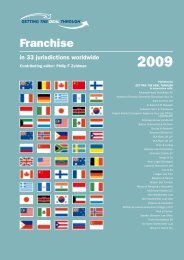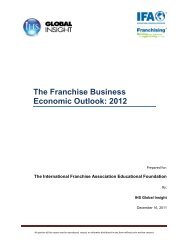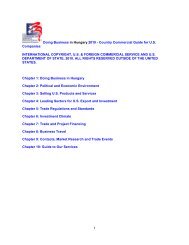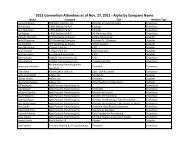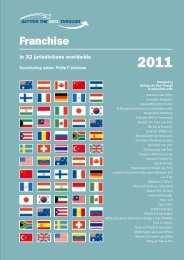South Africa - International Franchise Association
South Africa - International Franchise Association
South Africa - International Franchise Association
You also want an ePaper? Increase the reach of your titles
YUMPU automatically turns print PDFs into web optimized ePapers that Google loves.
_Buildings_14October2010.pdf<br />
A variety of incremental Green Technology measures can be expected in the<br />
foreseeable future, including:<br />
• A progressive carbon tax implemented in 2010 on fuel-inefficient internal<br />
combustion motor vehicles, going hand-in-hand with mandating the latest<br />
technology fuels from <strong>South</strong> <strong>Africa</strong>n oil refineries to power EURO 5-compliant<br />
internal combustion engines.<br />
• An increased focus on recycling, water efficiencies and treatment and waste<br />
management;<br />
• A sharply increasing electricity tariff regime (recently announced by the <strong>South</strong><br />
<strong>Africa</strong>n regulator to be increasing by 25 percent per year on average over three<br />
years).<br />
• Increasing the efficiencies of the Eskom-dominated power grid. With the<br />
increased tariff regime, cost structures may become more attractive for<br />
Independent Power Providers (IPPs).<br />
• Long term, the development of a Smart Grid.<br />
• A reduction of <strong>South</strong> <strong>Africa</strong>’s coal energy reliance - around 92 percent of all<br />
power generation is coal based;<br />
• The use of Clean Coal Technologies (CCT), which may alleviate some pressure<br />
to reduce reliance on coal power generation.<br />
• Medium term, the establishment of a nuclear power generation capacity, to<br />
supplement the only, problem-prone, facility at Koeberg in the Western Cape<br />
(commissioned in 1984, Koeberg has a capacity of 1,800MW and supplies six<br />
percent of <strong>South</strong> <strong>Africa</strong>'s electricity needs).<br />
• The use of commercial-scale CCS technologies in the future for both power<br />
generation and the Coal to Liquid (CTL) petro-chemical industry – at present a<br />
cornerstone of the <strong>South</strong> <strong>Africa</strong>n petrochemical landscape.<br />
• The use of solar and (to a lesser degree) wind power generation as a long- term<br />
Green Technology option, given the country’s abundant sunshine and long coast<br />
line.<br />
Industry sector developments in this field overlap with these headings, as treated<br />
elsewhere in this CCG:<br />
• Pollution Control Equipment<br />
• Electrical Power Systems<br />
• Green Building Technology<br />
• Standards (in Chapter 5)<br />
•<br />
Electrical Power Systems Return to top<br />
Overview Return to top<br />
Eskom, <strong>South</strong> <strong>Africa</strong>’s national power utility, generates about 95% of electricity in <strong>South</strong><br />
<strong>Africa</strong>. Approximately 88% of <strong>South</strong> <strong>Africa</strong>’s electricity is generated in coal fired power<br />
stations. Koeberg, a large nuclear station near Cape Town, provides about 6.5% of<br />
capacity. A further 2.3% is provided by hydroelectric and pumped storage schemes.<br />
<strong>South</strong> <strong>Africa</strong> supplies two thirds of <strong>Africa</strong>’s electricity and is one of the cheapest









